Episode #333: How Do I Engage My Students When Teaching a Split-Level Math Class | Equitable Math Lessons
LISTEN NOW HERE…
WATCH NOW…
Are you struggling to manage a math classroom with students learning at different paces while still creating engaging, equitable experiences for everyone?
In this episode, we tackle the challenge of teaching split classes with staggered student groups—something many educators face in today’s flexible and evolving classroom models. Whether you teach mixed-ability classes, blended learning environments, or block schedules, the strategies shared here can help you ensure no student gets left behind.
What you’ll learn:
- Learn how to balance structured group activities with independent, self-paced work.
- Discover an innovative “flip-flop” strategy to provide rich problem-solving opportunities for all students.
- Gain actionable ideas for fostering collaboration and creating advocates within your classroom.
Tune in now to learn practical approaches for managing split classrooms and ensuring every student gets the math moments they deserve!
Attention District Math Leaders:
Not sure what matters most when designing math improvement plans? Take this assessment and get a free customized report: https://makemathmoments.com/grow/
Ready to design your math improvement plan with guidance, support and using structure? Learn how to follow our 4 stage process. https://growyourmathprogram.com
Looking to supplement your curriculum with problem based lessons and units? Make Math Moments Problem Based Lessons & Units
Episode Summary:
Preparing Podcast Recording and Format
Jon and William had a technical discussion about setting up for a podcast recording. After resolving the audio issues, they discussed the structure of the podcast, including the absence of Kyle due to other commitments. Jon explained the usual format of the podcast, which involves asking guests about their ‘math moment’, a memorable experience from their time in math class. William agreed to this format, and they prepared to begin the recording.
William’s Customized Program Concerns
William, a teacher from Watertown, South Dakota, shared his experience with a customized program he implemented five years ago. The program, which includes algebra and geometry classes, allows students to work at their own pace and finish high school in two years while also taking college classes. However, William expressed concerns about the recent changes in the Academy’s leadership and the addition of students who join his class halfway through the semester. He is uncertain about how to address the needs of these students while ensuring the first-half students receive the necessary attention. Jon acknowledged William’s concerns and promised to restate them.
Incorporating ‘Math Moment’ in Presentations
Jon and William discussed the importance of incorporating a ‘math moment’ into their presentation. Jon sought clarification from William about his experiences with math, particularly his realization that math is a social activity. William shared a moment from his past where he struggled with math but found clarity and understanding through collaboration with his peers. This experience led William to believe that math cannot be effectively learned in isolation and should be approached as a social activity.
Social Interaction in Math Classrooms
Jon and William discussed the importance of social interaction in learning and how it’s not being effectively translated into math classrooms. Jon, drawing from his experience as a teacher, highlighted how he had isolated students in his class and how this approach might not be ideal. He suggested that William’s approach, which seems to involve more social and collaborative elements, might be a better fit. William, however, did not provide specific details about his current teaching methodology.
Math Teaching Approach and Guidance
William explained his approach to teaching math, emphasizing the importance of assigning tasks based on individual student needs and abilities. He shared that he starts each class with a thinking activity, followed by small group work. William also highlighted the benefits of having students who are ahead of the class serve as advocates and assist their peers. JON confirmed his understanding of this approach, noting that the teacher’s role is to guide students to the learning goal rather than dictate it. They also discussed the importance of randomized grouping and the potential for students to learn from each other.
Managing Paced Groups in Classroom
Jon and William discussed the challenges of managing different paced groups in their classroom. William expressed concern about how to provide an equal education experience for all students, especially those who may have already learned the material. Jon acknowledged the value of problem-solving and discussion in learning, and both agreed on the importance of ensuring all students have the opportunity to engage in these activities. They left the meeting with an open question about how to best address this issue.
Managing Split Classes and Coordination
Jon shared his experience of managing a split class in a small school setting, where he taught two different courses in the same 75-minute period. He suggested a strategy of alternating between a thinking lesson and purposeful practice questions to keep both groups engaged and on task. He emphasized the importance of coordinating learning goals and ensuring that each group received what they needed. He also noted that the specific structure of the classes might not be crucial, but rather the focus on providing students with different learning experiences.
Equitable Learning Experience in Mathematics
Jon and William discussed the importance of providing an equitable learning experience for all students in mathematics. Jon emphasized the need to ensure all students receive the same opportunities and to be flexible and creative in teaching methods. William agreed and shared his experience of using a “flip-flop” approach, where students alternate between individual and group activities, to ensure all students receive the same education. They planned to revisit this approach mid-year to evaluate its effectiveness and discuss any adjustments.
Be Our Next Podcast Guest!
Join as an Interview Guest or on a Mentoring Moment Call
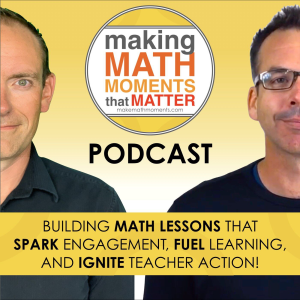
Apply to be a Featured Interview Guest
Book a Mentoring Moment Coaching Call
Are You an Official Math Moment Maker?
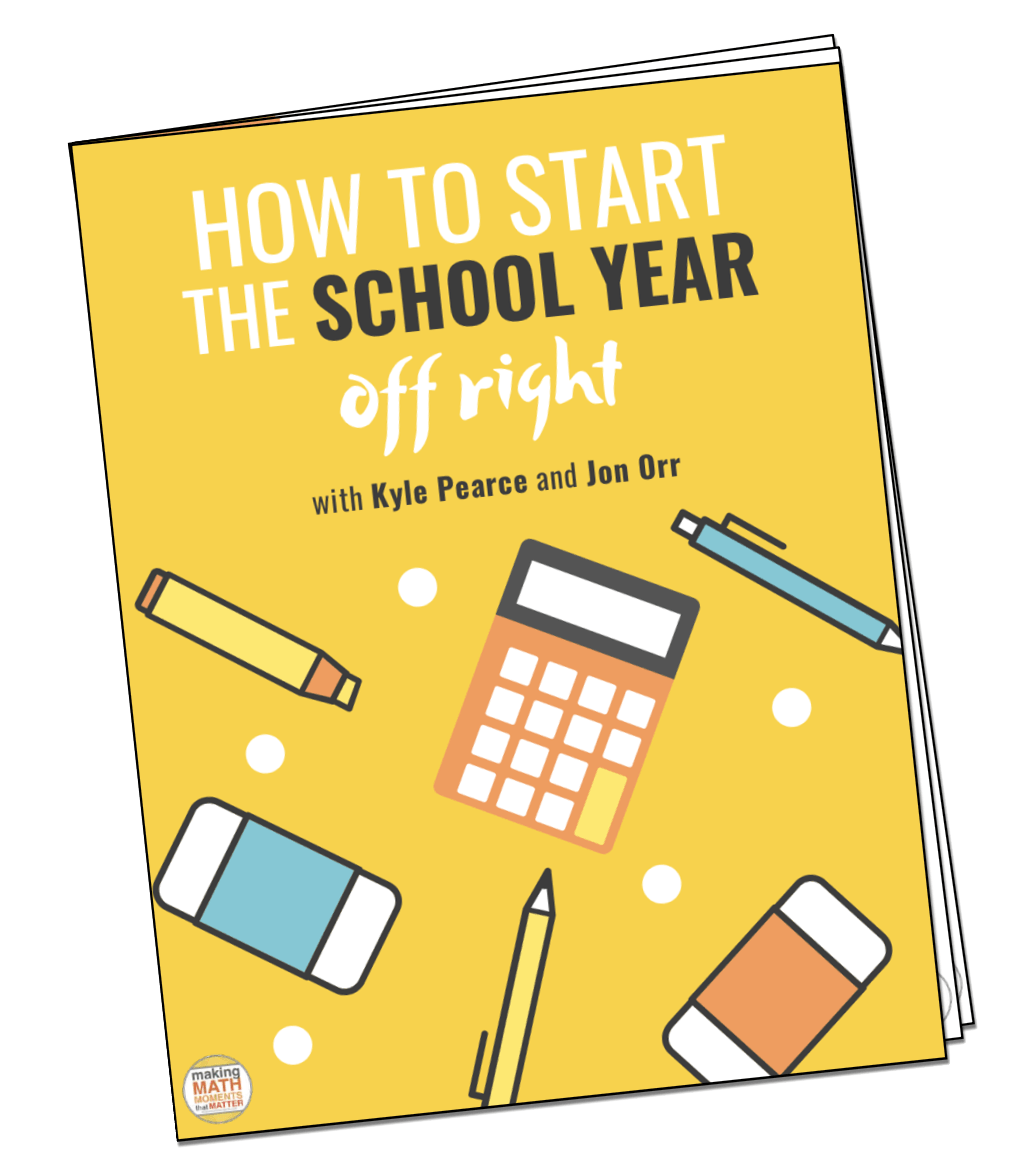
FULL TRANSCRIPT
Hey there, William! Welcome to the Making Math Moments That Matter Podcast. We’re always excited to dig into a fellow math moment maker and hear what’s going on in your world. Let us know where you’re coming from—what’s your teaching role right now?
William: Well, I teach in Watertown, South Dakota, which is in the northeast part of the state. Been here for 30 years and just started my 31st year in this school district—36 overall. So, wow. It’s not my first rodeo.
No, you’ve been around.
But it is a new horse.
I like that, I like that.
And I teach in—about five years ago, we started a customized program. If you’ve ever read the Khan Academy’s One Room Schoolhouse, that’s what we have. We have a huge room, and each section is cordoned off to our core classes. I teach Algebra and Geometry.
Then, the kids go outside once they’re juniors. Most of them do dual credit. The whole idea when we started this program was to get them done with their high school classes in two years and work on college classes. But we found out after we started that they can’t get financial aid because they don’t have the degree yet.
Right.
It’s kind of worked out that way. But the whole idea is to fill in the holes as they work through there.
Got it. So, tell me about your classes—what are you teaching right now?
I have Algebra I and Geometry.
And the reason I contacted you is in the past few years, when you get different leadership, the role of the academy has changed. I teach a 90-minute block for a semester, but I also have kids who are in my class for 45 minutes for the whole year.
William: And it worked out pretty well the past couple of years because the kids who came in for 45 minutes were usually my accelerated, super-accelerated kids. They came from the middle school up to the high school to take classes, and they would either just do their independent work outside the class or just keep working in the second semester as I went through with the rest of the class.
That worked out okay because we would build everything in the first 45 minutes, or try to keep it even less than that to give them some work time. But now my concern this year is they threw in a bunch of kids who start the second half of class.
So, the kids in the first half will get everything, and I don’t want to abandon the second group either, because that’s kind of the nice part of the program—being able to help them, address them, and redirect them when needed.
Right. But you’re concerned about managing the second group coming in?
Exactly. I have 26 kids in the block, and I’ve got 10 each in the skinnies (45-minute periods). My concern is: how do I build those moments with the kids who come in during the second half of class?
Got it. So, it’s all fluid, happening within the same 85 minutes, but you’re trying to figure out how to ensure that second group gets the same attention and experience.
Right.
So, tell me: what does the class look like at the start? What are you doing with the first group? Paint us a picture.
Well, typically I start my class with an activity—usually a thinking classroom-type activity or some problems that pertain to what we’re learning. Then, the second half of the block, they work in small groups.
Since the kids work at their own pace, I’ll have some kids ahead and some kids behind. So, they regroup depending on where they’re at. The kids who are a few days ahead of me will work in a pod together. Most of the kids are on pace, and then a few kids who are behind usually sit closer to me so I can get them caught up.
So, in the first half, everyone’s doing the same thinking task, even though they might be at different spots in their assignments?
Yes. The kids are assigned to a class now, and we sit in a big group. I start with a thinking task, and then in the second half, they work independently or in small groups.
What happened last year is the kids who were a couple of days ahead became my best advocates. They would come up to me with questions, and I would know where the other students might struggle. It worked out pretty well.
That makes sense. Are you noticing that the kids who are ahead take over in groups when you mix them, or is there good problem-solving happening?
Honestly, the problem-solving works out pretty well. The tasks I give them are often divergent, even though most of the assignments are convergent. So, even if the advanced kids have already done the assignment, they understand the vocabulary and the process, but it’s still about problem-solving.
The challenge, though, is when the second group comes in. I’m running around the room, trying to help kids, and I don’t want the second group to miss out. The first group is already working independently, but I don’t want to neglect those new kids.
Right. And what’s your concern about what happens with that second group?
I just don’t know how to build those moments for them. I don’t want to short-change them. The kids in the block are getting the experience I want, but I’m worried about the kids who come in later.
What do you want to do for them? Is there something you’re leaning toward, but you’re not sure it will work?
I thought about grouping the kids in the second half together and doing a small-group setting with them. But I’m worried about getting interrupted by questions from the first group. I want to give the second group the same opportunities without losing control of the class.
It sounds like you’re trying to balance equity for all students, so everyone gets the same rich experience.
Exactly.
Here’s something to consider. What if you “flip-flop” the activities? Let’s say the first group does the thinking task during the first half, and then they move on to purposeful practice during the second half. When the second group comes in, you run the same thinking task for them. Then, the next day, you flip it. The first group starts with purposeful practice, while the second group does the thinking task they missed.
That way, every student gets the opportunity for the same level of problem-solving and collaboration, even if they’re staggered.
William: That flip-flopping really hit me. I think that makes a lot of sense. I was reflecting on this for the past couple of weeks, and that never occurred to me.
Some days, I’ve had tasks that I thought we’d finish in 90 minutes, but we didn’t even get close. So, if I alternate thinking tasks and purposeful practice every other day, that could help balance everything out.
Exactly. It’s not an ideal situation, but you’re working with the constraints you have. By focusing on your core beliefs—what you value in math instruction—you can make sure every student gets the experience they deserve.
William: Yeah, I agree. It’s about equity. It’s not necessarily the same activity every day, but every student gets the same education throughout the year. I like that.
That’s great to hear! You’ll try it out, and I’d love to check back with you halfway through the year to see how it’s going. Would you be open to coming back and sharing your experience?
Sure, no problem.
Awesome. What would you say is your big takeaway from today’s call?
That I can flip-flop activities to ensure all students get the same experience. Even if I have to run some activities twice, that’s okay. The social part of math is so important to me, and this approach helps me stick to that value.
Love it. I can’t wait to hear how it goes! William, thanks for joining us today.
Well, thank you.
Take care.
Bye.
Thanks For Listening
- Book a Math Mentoring Moment
- Apply to be a Featured Interview Guest
- Leave a note in the comment section below.
- Share this show on Twitter, or Facebook.
- Leave an honest review on iTunes. Your ratings and reviews really help and we read each one.
- Subscribe on iTunes, Google Play, and Spotify.
DOWNLOAD THE 3 ACT MATH TASK TIP SHEET SO THEY RUN WITHOUT A HITCH!
Download the 2-page printable 3 Act Math Tip Sheet to ensure that you have the best start to your journey using 3 Act math Tasks to spark curiosity and fuel sense making in your math classroom!
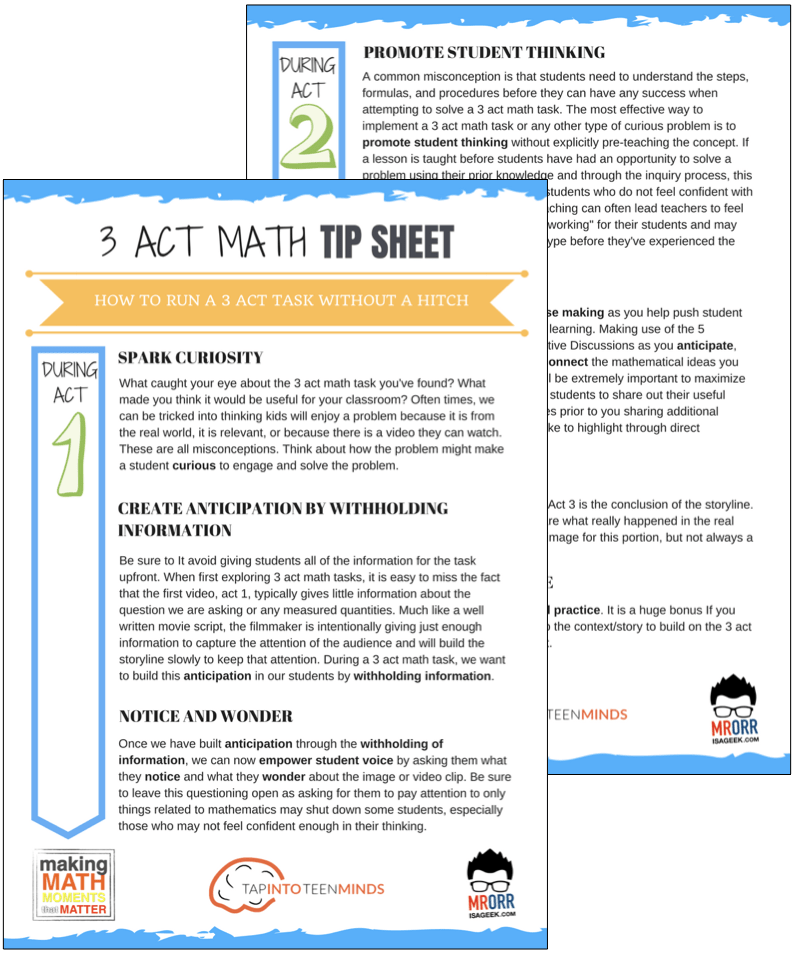
LESSONS TO MAKE MATH MOMENTS
Each lesson consists of:
Each Make Math Moments Problem Based Lesson consists of a Teacher Guide to lead you step-by-step through the planning process to ensure your lesson runs without a hitch!
Each Teacher Guide consists of:
- Intentionality of the lesson;
- A step-by-step walk through of each phase of the lesson;
- Visuals, animations, and videos unpacking big ideas, strategies, and models we intend to emerge during the lesson;
- Sample student approaches to assist in anticipating what your students might do;
- Resources and downloads including Keynote, Powerpoint, Media Files, and Teacher Guide printable PDF; and,
- Much more!
Each Make Math Moments Problem Based Lesson begins with a story, visual, video, or other method to Spark Curiosity through context.
Students will often Notice and Wonder before making an estimate to draw them in and invest in the problem.
After student voice has been heard and acknowledged, we will set students off on a Productive Struggle via a prompt related to the Spark context.
These prompts are given each lesson with the following conditions:
- No calculators are to be used; and,
- Students are to focus on how they can convince their math community that their solution is valid.
Students are left to engage in a productive struggle as the facilitator circulates to observe and engage in conversation as a means of assessing formatively.
The facilitator is instructed through the Teacher Guide on what specific strategies and models could be used to make connections and consolidate the learning from the lesson.
Often times, animations and walk through videos are provided in the Teacher Guide to assist with planning and delivering the consolidation.
A review image, video, or animation is provided as a conclusion to the task from the lesson.
While this might feel like a natural ending to the context students have been exploring, it is just the beginning as we look to leverage this context via extensions and additional lessons to dig deeper.
At the end of each lesson, consolidation prompts and/or extensions are crafted for students to purposefully practice and demonstrate their current understanding.
Facilitators are encouraged to collect these consolidation prompts as a means to engage in the assessment process and inform next moves for instruction.
In multi-day units of study, Math Talks are crafted to help build on the thinking from the previous day and build towards the next step in the developmental progression of the concept(s) we are exploring.
Each Math Talk is constructed as a string of related problems that build with intentionality to emerge specific big ideas, strategies, and mathematical models.
Make Math Moments Problem Based Lessons and Day 1 Teacher Guides are openly available for you to leverage and use with your students without becoming a Make Math Moments Academy Member.
Use our OPEN ACCESS multi-day problem based units!
Make Math Moments Problem Based Lessons and Day 1 Teacher Guides are openly available for you to leverage and use with your students without becoming a Make Math Moments Academy Member.
Partitive Division Resulting in a Fraction
Equivalence and Algebraic Substitution
Represent Categorical Data & Explore Mean
Downloadable resources including blackline masters, handouts, printable Tips Sheets, slide shows, and media files do require a Make Math Moments Academy Membership.
ONLINE WORKSHOP REGISTRATION
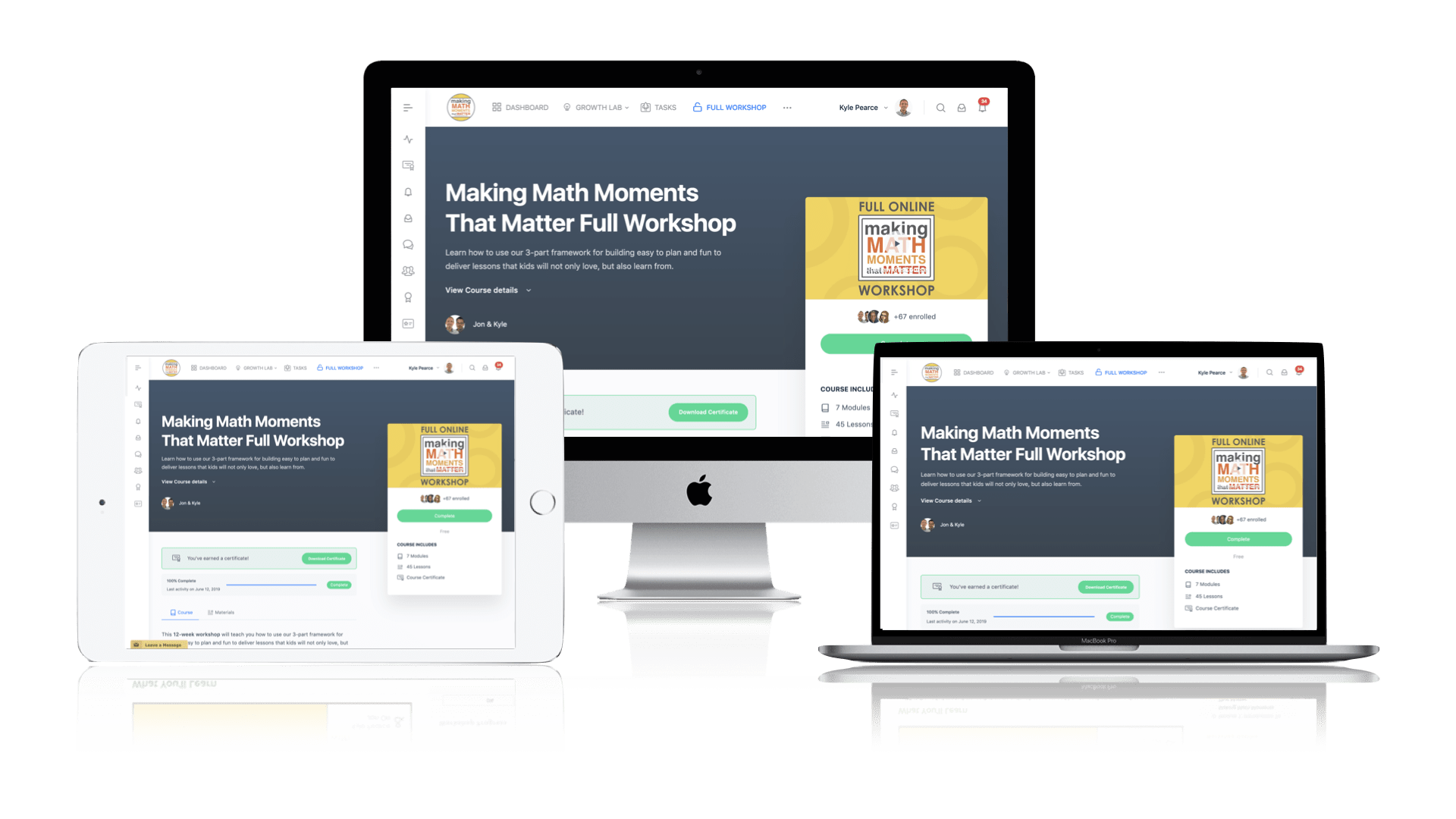
Pedagogically aligned for teachers of K through Grade 12 with content specific examples from Grades 3 through Grade 10.
In our self-paced, 12-week Online Workshop, you'll learn how to craft new and transform your current lessons to Spark Curiosity, Fuel Sense Making, and Ignite Your Teacher Moves to promote resilient problem solvers.




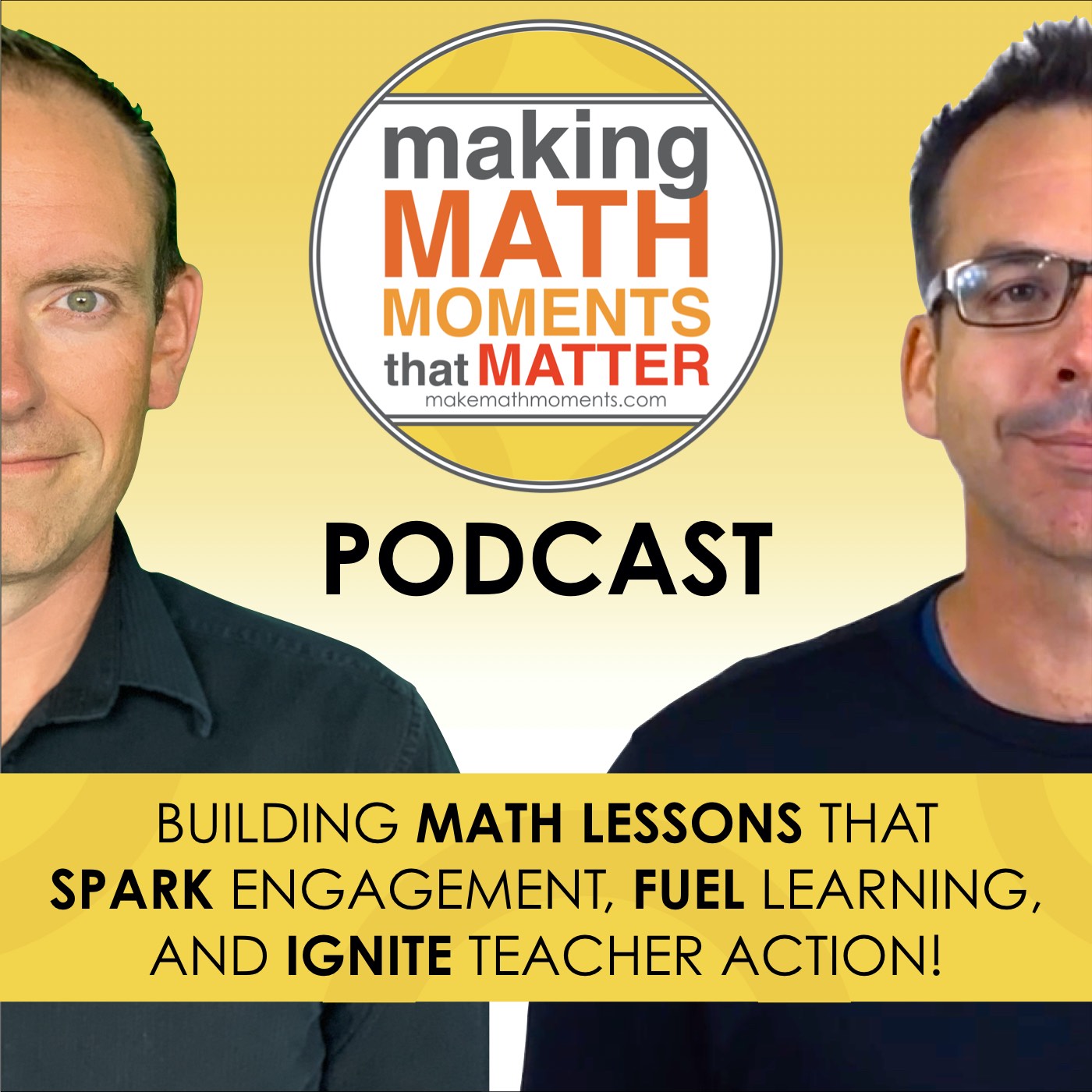
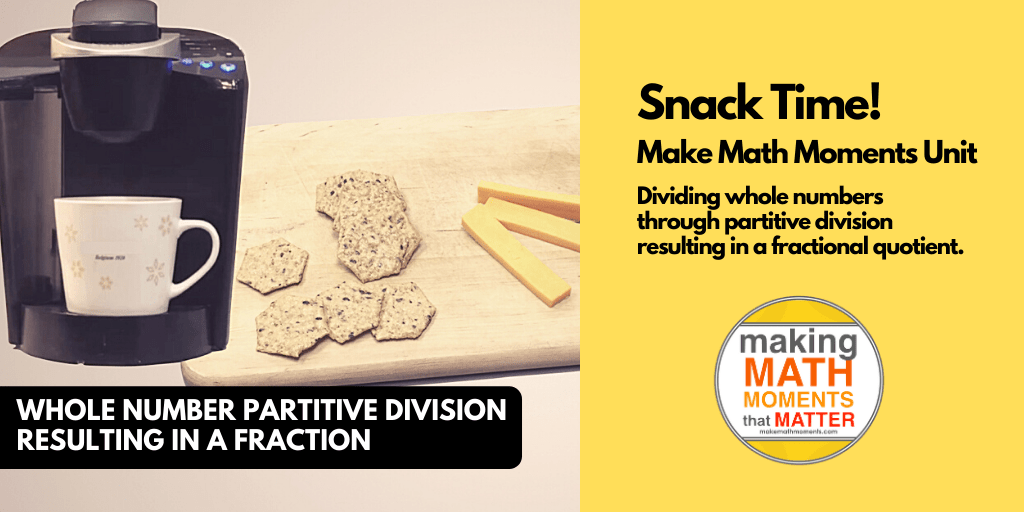
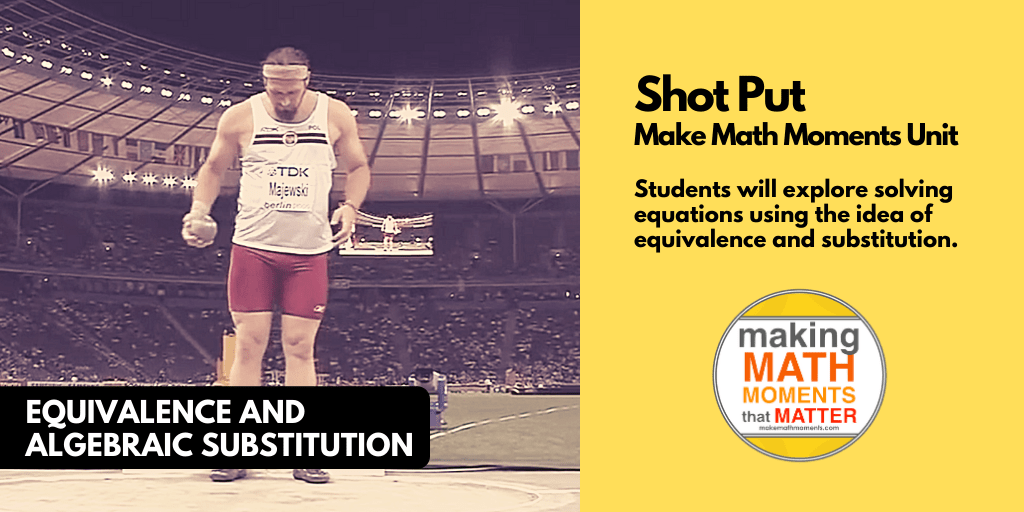
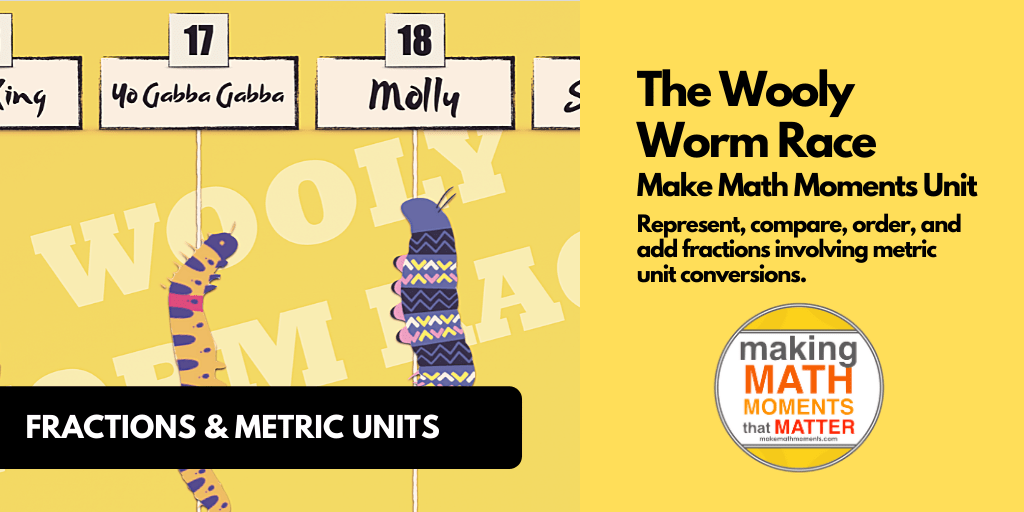


0 Comments